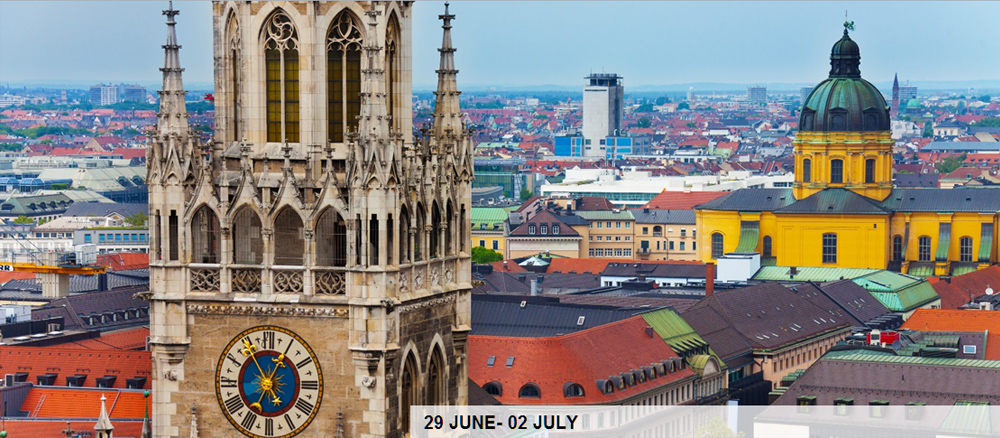|
28 & 29 June, 2015 – Munich, Germany
NANOSIZED- & NANO-STRUCTURED MATERIALS MADE by
NATURE and MAN: FUNDAMENTALS AND APPLICATIONS
INSTRUCTOR:
Prof. Dr. Prof. h.c. Dr. h.c Stan Veprek
Technical University Munich,
Germany
Course Brochure (PDF)
1. Introduction and short overview
- Charging by one electron
- How old is nanotechnology? (color of old glasses)
- Nanotechnology made by nature
- Often we are using nanotechnology without knowing it
- Nanoscience & Nanotechnology: Why and when (scientific facts vs. fiction)
2. Properties of nano-sized and nano-structured materials when approaching the molecular size
- Localization phenomena (crystallite size and separation):
- Electronic states
- Surface plasmons
- Phonons
- Nano-materials in
- Microelectronics
- Optoelectronics
- Nanomagnets approaching the domain size (efficient transformers, hard memory discs,
medical applications):
- Organization at nanoscale: Self-organization (bottom-up) vs. lithography & etching (top-
down)
- Thermodynamics properties of nano-sized materials
- Surface properties of nano-sized materials (fundamentals, nanosilver & nanogold in the
catalysis and in everyday life)
- Mechanical properties at nanoscale
- Learning from nature:
- super-hydrophobic, self-cleaning surfaces (“lotus effect” made by nature and by man)
- "lotus effect" upside down (super-adhesive surfaces made by nature and by man)
- hierarchic design of high-specific strength & toughness
- design of structural colors (origin of the colors of peacock, butterflies, …)
3. Structural bulk nanocomposites:
- Graphite fibres carbon composites with high specific strength
- Polymer-based nanocomposites reinforced by inorganic fillers
- Future trends: carbon and c-BN nanotube reinforced nanocomposites
4. Wear protection and functional nano-structured coatings for machine parts and tools:
- The role of the ratio of elastic modulus to hardness for wear of machine parts
- Self-lubricant hard nanocomposites for harsh and variable environment (humid-dry, low- &
high-temperature etc.; e.g. coatings in the machine of your car)
- Why coatings on tools? (Transition Metal Nitrides, Carbides, Borides, Oxides)
- Nanocrystalline diamond and diamond-like carbon
5. The Recent Search for New Superhard Materials: Go Nano!
5.1. Different approaches to superhard coatings, their advantages and drawbacks:
- Why the intrinsically superhard materials will hardly reach the hardness of diamond
- Hardening by energetic ion bombardment
- Superhard heterostructures
- Superhard nanocomposites reaching the hardness of diamond: Design concept, their
preparation, properties and recent progress in their understanding.
5.2. Industrial applications of hard and superhard nanocomposites in comparison to other
advanced coatings including polycrystalline diamond.
6. Summary and Conclusions
Professor Stan Veprek received his diploma in physics from the Charles University in Prague in 1963, and immediately began his work on the deposition of thin films by means of plasma CVD at the Institute of Physics of the Czech Academy of Science. His first major result was the deposition of nanocrystalline Si and Ge by means of chemical transport in hydrogen plasma (published in 1968). Nowadays, nc-Si is an important material for large-scale microelectronics, flat panel displays and thin films solar cells. Between 1968 and 1971 he was visiting scientist at the University Münster (Germany), where he continued his work in plasma chemistry. He received his Dr Phil. in chemistry (1972) and habilitation (1977) from the University of Zurich, where he became involved also in the research of the plasma-wall interactions in the TOKAMAK devices for controlled nuclear fusion. In 1976 he proposed and later developed the in-situ plasma CVD of boron carbide protective coatings ("boronization"), which found successful application in many large TOKAMAK devices around the world.
His continuing interest in nc-Si resulted, among others, in the classical papers on Raman scattering and phonon confinement, later extended to in-depth studies of the photoluminescence from nc-Si/SiO2nanocomposites. Together with the Swiss national museum he developed a new plasma-chemical method for the restoration and conservation of archeological metallic artifacts.
REGISTRATION:
Registration form here (doc.)
REGISTRATION FEE:
Regular registration: 880, € (*)
DSL / ACEX Participants: 480, € (*)
(*) until 15 March, 2015
After 15 March, 2015:
980, € (Regular registration)
480, € ( DSL/ACEX Participants)
Registration includes:
- 2 Full Days Course,
- Printed Course Materials, in Book Format
- Course Certificate,
- 2 Refreshments Daily,
- Lunch at Hotel Venue (Daily / 2 Days)
For more information, contact:
Dr. Meire Gomes
Meire.gomes@icc-conferences.com

|
IMPORTANT DATES:
Abstract Submission is OPEN!
Deadline for Abstract Submission:
16th FEBRUARY, 2015
(note that it is not compulsory to submit an Abstract to attend the Conference)
Notification of acceptance:
until 20th FEBRUARY, 2015
Early Bird Registration: until 15th MARCH, 2015
Reduced Registration Fee
Until 20th December, 2014
Deadline for Full Paper
Submission:
Until 15th July, 2015
(Not compulsory to submit a Full
Paper / Manuscript)
ADVANCED COURSES
28 & 29 June, 2015
ACEX2015:
29 June-02 July, 2015
|




